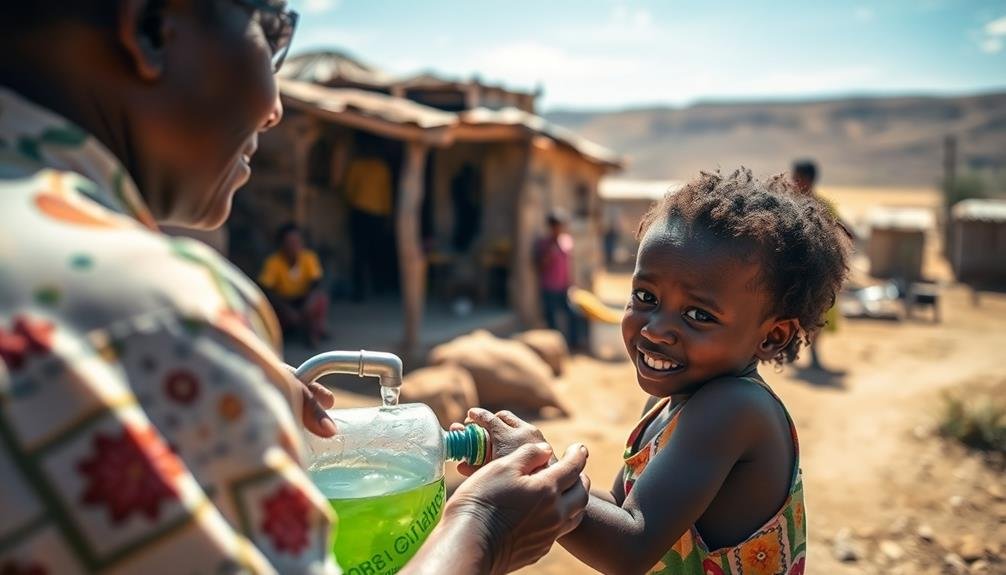To create powerful visual narratives for nonprofits, focus on three key techniques. First, capture authentic moments by patiently observing and anticipating genuine emotions and interactions. Second, use impactful composition techniques like the rule of thirds, leading lines, and creative angles to guide viewers' attention and add depth to your images. Third, create emotional connections by highlighting the human element, using close-ups, and paying attention to details that tell a larger story. By mastering these visual storytelling tips, you'll be able to produce compelling photographs that effectively communicate your nonprofit's mission and impact. Explore each technique to reveal the full potential of your nonprofit photography.
Capture Authentic Moments

Three key elements can help you capture authentic moments in nonprofit photography: patience, observation, and anticipation.
Patience allows you to wait for genuine emotions and interactions to unfold naturally. Don't rush your subjects; instead, give them time to become comfortable with your presence and forget about the camera.
Observation is essential for identifying compelling stories and moments. Pay attention to body language, facial expressions, and interactions between individuals. Look for details that convey the organization's mission and impact.
Train your eye to spot potential visual narratives that will resonate with your audience.
Anticipation involves predicting when significant moments might occur. Learn about the nonprofit's activities and routines, and position yourself accordingly. Be ready to capture spontaneous reactions, heartfelt exchanges, or pivotal moments in the organization's work.
Use candid shots rather than posed images whenever possible. Encourage natural behavior by blending into the background and using a longer lens.
Avoid directing your subjects; instead, document real-life situations as they happen. This approach will result in more authentic, emotionally powerful images that effectively tell the nonprofit's story and connect with viewers on a deeper level.
Use Composition for Impact

Strong composition techniques can elevate your nonprofit photography from good to great. To create impactful images, start by applying the rule of thirds. Divide your frame into a 3×3 grid and place key elements along these lines or at their intersections. This creates balance and draws the viewer's eye to important aspects of your story.
Use leading lines to guide the viewer's gaze through the image. These can be natural elements like roads or rivers, or man-made structures like fences or buildings. They'll help create a sense of depth and direct attention to your main subject.
Don't forget about framing. Use doorways, windows, or natural elements to frame your subject, adding context and focusing attention. Experiment with different angles and perspectives to add visual interest. Get low or high, or try shooting from unusual vantage points to create unique compositions.
Pay attention to symmetry and patterns, which can create visually striking images. Conversely, breaking patterns can highlight your subject effectively.
Create Emotional Connections

Capturing emotions is at the heart of compelling nonprofit photography. Your goal is to create images that resonate with viewers and inspire action. To achieve this, focus on the human element in your shots. Seek out genuine moments of joy, struggle, or triumph that reflect your organization's mission.
When photographing individuals, don't be afraid to get close. Fill the frame with expressive faces and body language that convey powerful emotions. Encourage your subjects to relax and be themselves, capturing their authentic reactions and interactions.
Look for small details that tell a bigger story, like weathered hands or tearful eyes. Use lighting to enhance the mood of your images. Soft, natural light can create a sense of warmth and intimacy, while dramatic shadows can emphasize struggle or determination.
Pay attention to the background and surrounding elements, ensuring they contribute to the overall emotional impact without distracting from the main subject.
Frequently Asked Questions
What Camera Equipment Is Essential for Nonprofit Photography?
You'll need a reliable DSLR or mirrorless camera, versatile lenses (wide-angle and telephoto), a sturdy tripod, and a flash. Don't forget extra batteries, memory cards, and a comfortable camera bag for easy transport.
How Can Photographers Obtain Consent From Subjects in Sensitive Situations?
When photographing sensitive situations, you'll need to approach subjects respectfully. Explain your purpose clearly, use simple consent forms, and offer anonymity options. Always prioritize the subject's comfort and dignity, and be prepared to walk away if they're hesitant.
Are There Legal Considerations When Photographing Minors for Nonprofit Work?
Yes, there are legal considerations when photographing minors. You'll need parental consent and should be aware of privacy laws. Don't share identifiable images without permission. Always prioritize the child's safety and well-being in your nonprofit work.
How Can Nonprofits Effectively Organize and Manage Their Photo Libraries?
You'll want to use a robust digital asset management system. Organize photos by date, event, and subject. Tag images with relevant keywords. Implement a consistent naming convention. Regularly backup your library and guarantee proper permissions are in place.
What Are Best Practices for Captioning and Crediting Nonprofit Photographs?
You should always provide clear, concise captions that describe the image's content and context. Don't forget to credit photographers properly. It's essential to obtain necessary permissions and include relevant details like date, location, and subjects' names when appropriate.
In Summary
You've now got the tools to take your nonprofit's visual storytelling to the next level. Remember to capture genuine moments, use composition techniques for maximum impact, and create emotional connections with your audience. By applying these tips, you'll transform your photography from simple documentation to powerful narrative. Don't be afraid to experiment and find your unique style. With practice, you'll soon be telling compelling stories that inspire action and support for your cause.





Leave a Reply